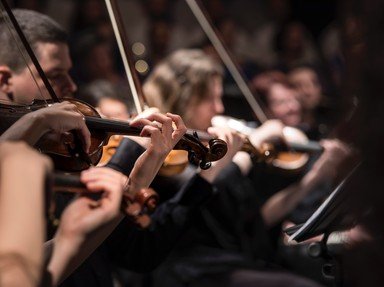Quiz Answer Key and Fun Facts
1. A famous madrigal by English composer Thomas Morley begins "April is in my mistress' face/ And July in her eyes hath place/ Within her bosom is September". Which month is in her heart?
2. A madrigal by German composer Heinrich Isaac is a lament by someone who must leave this Austrian city.
3. "Mon couer se recommande a vous" is a lovely French madrigal frequently attributed to the Flemish composer Orlando di Lasso. In fact, though, its authorship is uncertain.
4. "El Grillo" is a comic madrigal by French-born composer Josquin des Pres about this creature. (Think English sport)
5. "The Silver Swan" is the best-known madrigal by this English composer.
6. In 1601, Thomas Morley produced the great collection of madrigals entitled "The Triumphs of Orianna", which included works by several great madrigalists. What illustrious lady, who gave her name to an era in English history, was it composed in honor of?
7. An Italian madrigal by the Flemish composer Jacques Arcadelt has a text similar to that of "The Silver Swan". Which of these is it?
8. This madrigal by Italian opera composer Claudio Monteverdi is a choral arrangement of a famous lament from his opera "Arianna", based on the story of Ariadne and Theseus. In this aria, the abandoned heroine asks for death to relieve her despair.
9. This madrigal by Thomas Morley is used in Shakespeare's play "As You Like It" (the refrain ends with "Sweet lovers love the spring").
10. These two French composers wrote an epic madrigal describing a battle entitled "La Guerre" ("The War").
11. Another descriptive piece is the Spanish madrigal "La Bomba" which describes the crew of a sinking ship trying desperately to keep it from taking on water. What does the title "La Bomba" refer to?
12. The madrigal "Das Glaut zu Speyer", by the German composer Senfl, describes the following activity in a village on a church feast day:
13. English composer Orlando Gibbons wrote a madrigal evoking this beloved and, by the mid 1600s, already long established London tradition.
14. Two of English composer John Wilbye's most famous madrigals are about ladies with these names.
15. Not all madrigals were af a secular nature. Certain composers, most notably Palestrina, wrote so-called "spiritual madrigals" ("madrigali spirituali") which used a religious, though not liturgical text.
16. Musical settings of the Catholic Mass were sometimes based on madrigals or secular songs.
17. French composer Pierre Passereau's famous madrigal "Il est Bel et Bon", in which a woman boasts of cuckolding her husband while he is hard at work tending the farm, has the singers imitate the sounds of these barnyard animals.
18. A remarkable madrigal by Johannes Ockeghem entitled "S'elle M'amera /Petite Cammusette" mentions this legendary couple (hint- they are described as going "...off to the green wood").
19. "La Tricotea", an anonymous Spanish madrigal, and "Vitrum Nostrum Gloriosum", an anonymous German madrigal, are examples of what type of song?
20. Another famous madrigal by Thomas Morley celebrates the month when "Spring, clad all in gladness, doth laugh at winter's sadness." Which month is it?
21. "Come Again, Sweet Love Doth Now Invite", "Fine Knacks for Ladies", "Flow, my Teares", and "I Saw My Lady Weep" are by this composer of English/Irish ancestry.
22. There are also madrigals of mourning, written usually in memory of some departed loved one or famous personage. Which of these is NOT an example of this type of madrigal, despite its mournful title?
23. The famous Spanish composer Tomas Luis de Victoria, best known for his motet "O Magnum Mysterium" and "Missa pro Defunctis", is notable for having written not a single madrigal; his entire output consists of sacred choral music.
24. "Fa a una canzona" is one of the most famous Italian madrigals, widely performed by high school and college choirs as well as professional choruses. Which of these Italian composers wrote it? (His last name means "old")
25. The Italian nobleman Don Carlo Gesualdo wrote some of the most harmonically daring and inventive madrigals, as well as sacred music. Gesualdo's music reflects, to a degree, his rather turbulent psyche. What, besides his music, is he famous (or infamous) for?
Source: Author
jouen58
This quiz was reviewed by FunTrivia editor
Bruyere before going online.
Any errors found in FunTrivia content are routinely corrected through our feedback system.

